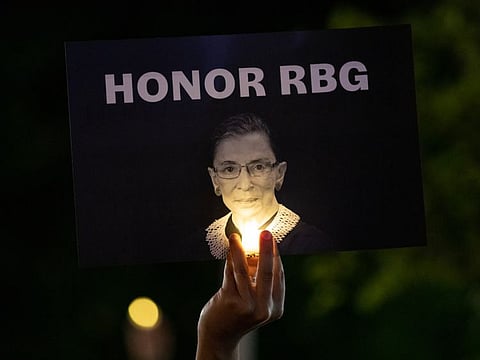After Ginsburg death, Trump presses for new justice ‘without delay’ as election looms
Tells campaign rally that his nominee ‘will be a woman’

Washington: President Donald Trump pressed Senate Republicans on Saturday to confirm his choice to replace Justice Ruth Bader Ginsburg “without delay” setting up a momentous battle sure to inflame the campaign as he seeks to force through an appointment in the weeks before the election November 3.
Trump said he expected to announce his nomination in the coming week and told a campaign rally that it “will be a woman,” gambling that he can scramble the dynamics of a campaign in which he is currently trailing and at the same time seal his legacy by cementing a conservative majority on the Supreme Court with his third appointment in four years.
Also Read: Impeachment charges against Trump explained
The president did not name his finalists, but in a telephone conversation Friday night with Sen. Mitch McConnell, the majority leader, according to two people familiar with the call, Trump identified two women as candidates: Judges Amy Coney Barrett of the 7th US Circuit Court of Appeals in Chicago and Barbara Lagoa of the 11th Circuit in Atlanta.
Trump offered praise for both judges when reporters asked about them Saturday afternoon before he flew to North Carolina for his rally. He called Barrett, who was a finalist for the last opening two years ago, “very highly respected” and said that while he did not know Lagoa, he had heard “incredible things” about her, noting that she is Hispanic and from Miami, in the battleground state of Florida.
Blocking Obama
The president rejected suggestions that he should wait to let the winner of the November 3 contest fill the vacancy, much as McConnell insisted four years ago in blocking President Barack Obama from filling an election-year vacancy on the court.
“We won and we have an obligation as the winners to pick who we want,” Trump said. “That’s not the next president. Hopefully, I’ll be the next president. But we’re here now, right now, we’re here, and we have an obligation to the voters, all of the people, the millions of people who put us here.”
It was not clear, however, whether McConnell has the votes to push through a nomination by November 3. In a message posted on Twitter on Saturday morning, the president called on Republican senators to act “without delay,” but in speaking with reporters he did not seem certain that it would happen before the election. “I would think before would be very good, but we’ll be making a decision,” he said. “I think the process could go very, very fast.”
Favourite
The White House has been working since spring on a plan to replace Ginsburg if the opportunity arose. The front-runner appeared to be Barrett, a favourite of anti-abortion conservatives, and Trump reportedly told confidants in 2018 that he was “saving her for Ginsburg.” But as he indicated, he sees a nomination of Lagoa as a way to appeal to Hispanic voters, especially in Florida.
Some aides were still suggesting other candidates, including Judge Amul R. Thapar of the 6th Circuit, who had previously been seen as a favourite of McConnell’s. The Senate leader made no comment on the names floated by the president in their phone call nor did he offer any of his own suggestions, said the people familiar with the conversation.
McConnell moved to stave off defections by sending a letter late Friday to Republican senators urging them to “keep your powder dry” and not “prematurely lock yourselves into a position you may later regret.” At least two Republicans have said they oppose jamming through a nominee so close to a presidential election, meaning McConnell, with a 53-47 majority and Vice President Mike Pence as a tiebreaker, could afford to lose only one more.
Some Republican strategists said it would make more sense for the president to name a choice right away and proceed with hearings but to wait for a Senate vote until after November 3 to give Republicans who have soured on Trump because of the coronavirus pandemic or other reasons an incentive to turn out to vote.
Sen. Susan Collins of Maine, the most endangered Republican up for election this year, said in a statement Saturday that the Senate could begin considering a nomination but should not vote before the election.
“In fairness to the American people, who will either be reelecting the president or selecting a new one, the decision on a lifetime appointment to the Supreme Court should be made by the president who is elected on November 3,” she said. Sen. Lisa Murkowski, R-Alaska, concurred in an interview Friday shortly before news of Ginsburg’s death.
But other Republicans backed an early vote, including Sen. Lindsey Graham of South Carolina, the Senate Judiciary Committee chair who had previously promised not to support confirmation of a Trump nominee in a presidential election year but flip-flopped Saturday to support the president’s effort to install his choice in the midst of a campaign.
Ginsburg’s death at 87 produced an outpouring of grief and anxiety among her admirers, with crowds gathered spontaneously late into the night at the Supreme Court building. As a lifelong champion of women’s rights and only the second woman to serve on the court, she became an unlikely icon for the left late in life, called the Notorious RBG.
No vacancy at the Supreme Court occurring so close to a presidential election in American history has been filled by Senate vote before the election. The closest came in 1916 when Chief Justice Charles Evans Hughes resigned 150 days before the election to run as the Republican candidate and his successor was confirmed before the balloting.
When a retirement opened up a seat before the 1956 election, President Dwight Eisenhower filled it with a recess appointment, reaching across the aisle to install a Democrat, William Brennan. After winning a second term, Eisenhower formally nominated Brennan for the lifetime position. The recess appointment was not controversial, and Brennan was confirmed with almost no opposition.
For today’s partisans, the more memorable precedent was Justice Antonin Scalia’s death in February 2016, which came 269 days before the election. McConnell blocked President Barack Obama from filling the seat with his nominee, Judge Merrick Garland, arguing that it was too close to the election.
“The American people should have a voice in the selection of their next Supreme Court justice,” McConnell said in a statement released after Scalia’s death. “Therefore, this vacancy should not be filled until we have a new president.”
McConnell later amended his rationale, saying it was not just proximity to the election that justified blocking a nominee but the fact that the president and the Senate majority at the time were held by opposite parties.
Democrats led by former Vice President Joe Biden, their presidential nominee, demanded that Republicans respect the precedent they set of not acting so close to a presidential election - in this case much closer - and threw McConnell’s words back at him.
In a conference call with fellow Senate Democrats on Saturday, Sen. Chuck Schumer of New York, the party leader, warned of possible retaliation if the Republicans forced a confirmation. “Let me be clear,” he told fellow senators, according to a person on the call. “If Leader McConnell and Senate Republicans move forward with this, then nothing is off the table for next year. Nothing is off the table.”
Some Democrats have argued that if they take control of the Senate, they should consider eliminating the filibuster used by the minority party to block legislation and potentially even add seats to the Supreme Court to offset what they consider Trump’s illegitimate appointments. The number of seats on the Supreme Court is set by law, not the Constitution, and has shifted over the years, but the last time a president tried packing the court by expanding it, Franklin Roosevelt suffered one of his biggest legislative defeats.
Trump views his conservative judicial appointments as one of his strongest arguments to motivate his base. Exit polls showed after the 2016 election that 26% of Trump’s voters considered the Supreme Court with its vacant seat the most important issue that year compared with just 18% of Hillary Clinton’s supporters.
At his campaign rally Saturday night in Fayetteville, North Carolina, the president boasted about his pending selection, firming up his commitment to picking a woman and leading the crowd in chants of “Fill that seat.” He “polled” the crowd, asking whether it preferred a woman or man and his supporters cheered for a woman.
Sign up for the Daily Briefing
Get the latest news and updates straight to your inbox









